why build if you can buy ?
That's a very good question... well, is Amateur Radio really the right hobby for you if you are not interested to build and experiment ? Of course nowadays you can buy the most fancy radio and antenna and don't have to worry about the way they work. In my early radio times I had to build part of my equipment myself simply because I could not afford to buy it as a poor student. But even nowadays where money is not as scarce as before, I still enjoy to build smaller bits and pieces myself and feel great when they work. Most of my "construction mania" was around the early 90's when I built various PAs, Preamplifiers, Power supplies, Transverters etc. mainly for the 2m and 70cm band. Unfortunately I sold most of that equipment very soon after I built it because I needed money for some other stuff. There are not even pictures available which is a pity looking backwards now. Among that equipment I built were.
- 2m dual stage Transistor PA with built in GaAsFet Preamp
- RTTY Filter Converter based on DJ6HP design
- 2m Transverter (10m IF) based on DK7ZB design
- 70cm Transverter (10m IF) based on DJ4LB/SSB Electronics design
- 6m Transverter (2m IF) own design
- 2m PA with 4CX350 and surplus cavity
- 70cm PA with 2x YD1270
- 70cm PA with 2x 2C39
- various Preamps for 2m and 70cm with MGF1302, CF300, BF981
- various HF antenna tuners
A 23cm Transverter with built-in 35W PA
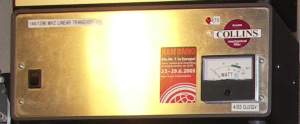
Based on the DB6NT design that delivers about 1W to drive two Mitsubishi PA modules in parallel for 35W total output power. Housed in standard green "Schubert" enclosure. The Transverter is connected to my Yaesu FT-857D and works with 144MHz as IF.
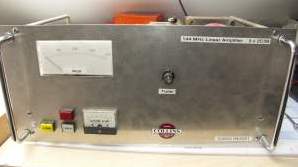
A quarter Kilowatt 2m PA with 3 times 2C39 tubes
based on the well known design mentioned in DJ9HO's UHF Unterlage. 2C39 tubes are very cheap, largely available on fleamarkets and I have never managed to break one in any of my amplifiers. I wrote a short summary about this for the Basingstoke ARC construction Contest which I entered in 2006 and my PA won 2nd price. Click here to download this summary.
A T7F packet radio Transceiver with built in YAM Modem
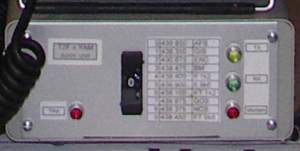
This unit was used for many years before I had a DSL connection in my shack. It's the T7F 70cm Transceiver with about 6W output power. The dial on the front allows to select one out of 10 programmed frequencies. The YAM-model is an FPGA based packet Radio modem for 1200/2400 and 9600 Baud - developed by IV3NWV. Unfortunately there are no XP or Vista drivers available for the YAM modem
An antenna swith box for 2 Radios and up to 5 Antennas
In a SO2R Station it is absolutely necessary to be able to connect each antenna to one of the two radios. Although there are commercial solutions available like the WX0B Sixpack, I built this box from parts in my junk box. It allows me to connect up to 5 antennas to each of my two Transceivers. The relais used are Matsushita type and can easily handle a kilowatt. The unit has proved to work with Linears in several Contests. There is of course a simple interlocking logic, so the two radios can never be connected to the same antenna (meaning to each other, hi)
A 9 dB 2m Yagi for less than 9 pounds
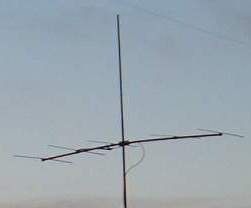
The idea for this antenna came when I participated in my first Foxhunt (ARDF) at Basingstoke ARC. The antennas used on the foxhunt receivers were based on a design by WB2HOL where the 3 elements are made of flexible metallic tape from standard tape measure. I thought well, it should be possible to build a bit larger antenna with this technique and use it for 2m portable operations. Here is a a detailed document available for download about the construction of this antenna . Recently I also used it as an indoor antenna after moving to my new QTH. With the antenna facing the eastern window of the house I worked some nice DX like UT2XQ on Tropo or RU1AA via Meteorscatter using just 150W and 5 elements indoor.
The Softrock RXTX V6.2 for 20/30m with integrated Keyer
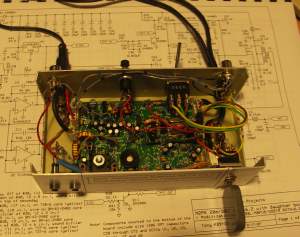
This is a really cool piece of equipment - mainly because of its simplicity. Togther with my shack PC who does all the DSP signal processing it allows me to
work QRP QSOs on 20m and 30m. With the help of a simple Quadrature Sample Decoder/Encoder it utilises the PC soundcard to process the I-and Q-signals directly mixed down to
baseband. The design is from Tony KB9YIG, and there is lots of detailed information available about this Transceiver on
Bodo DJ9CS's homepage 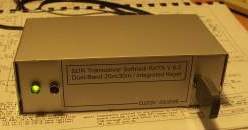 With the Software KGKSDR from Duncan M0KGK it is possible to do RX and TX with a single soundcard. To my knowledge all other programs
require a second soundcard to run the Transceiver. However KGKSDR does not YET support the connection of a morse paddle. That's why I decided to include the paddle and
the keyer circuit into the unit. The paddle is a simple dual position tip-switch and the circuit is the K9 using a PIC12F509 as described on
K1EL's Free Stuff page
With the Software KGKSDR from Duncan M0KGK it is possible to do RX and TX with a single soundcard. To my knowledge all other programs
require a second soundcard to run the Transceiver. However KGKSDR does not YET support the connection of a morse paddle. That's why I decided to include the paddle and
the keyer circuit into the unit. The paddle is a simple dual position tip-switch and the circuit is the K9 using a PIC12F509 as described on
K1EL's Free Stuff page
A second receiver for the TS-850 using a Sofrock based SDR Receiver.
- still under construction
2m Yagis with plastic booms based on DK7ZB design
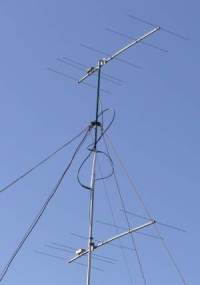
very simple construction - everything is explained on DK7ZB's excellent website. The only difference I made is that I do not use an N-Socket at the dipole. I built two 6 Element Yagis for 2m where a short length of Aircell-7 cable is directly connected to the Dipole. The choke is made of that cable too. The length is just long enough to allow stacking at a distance of about 2.2m. At this centerpoint I use a homemade 2-way splitter with N connectors. Standard PVC installation tubes of 25mm diameter are just ok to support a boomlength of 2m without guying the boom. The weight of this antenna is extremely low, so it could be mounted on a fiberglass telescopic tower (i.e. the Spiderbeam 12m or 18m version). Four of these antennas can easily be connected together using 3 T-junctions with N-connectors. The transformation lines between the two pairs need to match from 25 to 100 Ohms, so they can be made of standard 50 ohm cable. This allows a very easy 4-stack portable system for Contests etc.
A 30m vertical polarised delta loop.
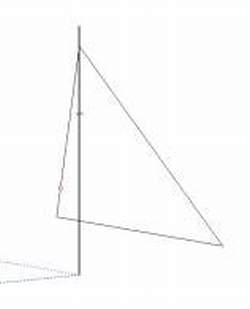
I like 30m - it's a very nice band for working DX. To get a low radiation angle a vertical polarised antenna is the best choice - unless one can put up a Yagi at a reasonable height. Quarter wave verticals need good ground properties (either radials or a low resistance earth). But in my situation I did not want to put up another pole with lots of radials in the garden. So I tried this vertical polarised loop along the guy wires of my telescopic tower. The main advantage is that it is more or less independent of the ground properties due to its full wavelength. The antenna is fed about 1m from the end of one of the sloping wires. The horizontal wire is only about 1.5m above ground in my installation - while the apex is at approx 9m. Due to the feedpoint resistance of ~100 Ohm matching is done with a quarter wave length of 75 Ohm TV-coax cable.
 |
|